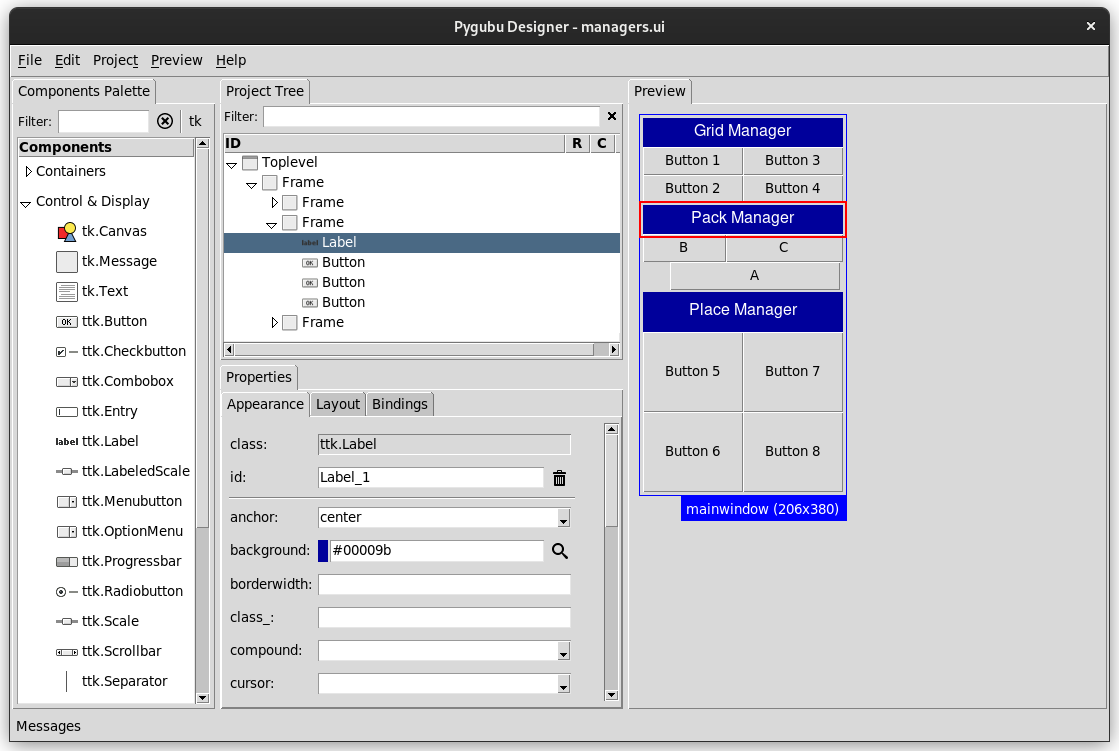Leer en Español. More translations here
Pygubu is a RAD tool to enable quick and easy development of user interfaces for the Python's tkinter module.
The user interfaces designed are saved as XML files, and, by using the pygubu builder, these can be loaded by applications dynamically as needed.
Pygubu is inspired by Glade.
The latest version of pygubu requires Python >= 3.8
You can install pygubu-designer using:
pip install pygubu-designer
Arch Linux (AUR)
yay pygubu-designer
Type on the terminal one of the following commands depending on your system.
pygubu-designer
C:\Python3\Scripts\pygubu-designer.exe
Where C:\Python3 is the path to your Python installation directory.
Now, you can start creating your tkinter application using the widgets that you
find in the top panel called Widget Palette.
After you finished creating your UI definition, save it to a .ui file by
going to the top menu File > Save.
The following is a UI definition example called helloworld.ui created using pygubu:
<?xml version='1.0' encoding='utf-8'?>
<interface version="1.2">
<object class="tk.Toplevel" id="mainwindow">
<property name="height">200</property>
<property name="resizable">both</property>
<property name="title" translatable="yes">Hello World App</property>
<property name="width">200</property>
<child>
<object class="ttk.Frame" id="mainframe">
<property name="height">200</property>
<property name="padding">20</property>
<property name="width">200</property>
<layout manager="pack">
<property name="expand">true</property>
<property name="side">top</property>
</layout>
<child>
<object class="ttk.Label" id="label1">
<property name="anchor">center</property>
<property name="font">Helvetica 26</property>
<property name="foreground">#0000b8</property>
<property name="text" translatable="yes">Hello World !</property>
<layout manager="pack">
<property name="side">top</property>
</layout>
</object>
</child>
</object>
</child>
</object>
</interface>Then, you should create your application script as shown below (helloworld.py):
# helloworld.py
import pathlib
import tkinter as tk
import tkinter.ttk as ttk
import pygubu
PROJECT_PATH = pathlib.Path(__file__).parent
PROJECT_UI = PROJECT_PATH / "helloworld.ui"
class HelloworldApp:
def __init__(self, master=None):
# 1: Create a builder and setup resources path (if you have images)
self.builder = builder = pygubu.Builder()
builder.add_resource_path(PROJECT_PATH)
# 2: Load an ui file
builder.add_from_file(PROJECT_UI)
# 3: Create the mainwindow
self.mainwindow = builder.get_object('mainwindow', master)
# 4: Connect callbacks
builder.connect_callbacks(self)
def run(self):
self.mainwindow.mainloop()
if __name__ == '__main__':
app = HelloworldApp()
app.run()Note that instead of helloworld.ui in the following line:
PROJECT_UI = PROJECT_PATH / "helloworld.ui"You should insert the filename (or path) of your just saved UI definition.
Note also that instead of 'mainwindow' in the following line:
self.mainwindow = builder.get_object('mainwindow', master)You should have the name of your main widget (the parent of all widgets), otherwise you will get an error similar to the following:
Exception: Widget not defined.
See this issue for more information.
Visit the wiki for more documentation.
The following are some good tkinter (and tk) references:
- TkDocs
- Graphical User Interfaces with Tk
- Tkinter 8.5 reference: a GUI for Python
- An Introduction to Tkinter (archive)
- Tcl/Tk 8.5 Manual
You can also see the examples directory or watch this introductory video tutorial.
See the list of changes here.
